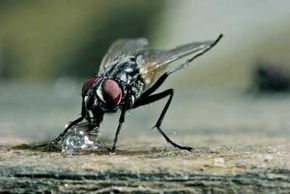Housefly Diet
Once a housefly sniffs something interesting and tastes it with its feet and palps, the time has come to gobble up the delicious morsel.
If the meal in question happens to be liquid already, then the task is easy. Since the housefly's mouth parts are designed to sponge and ingest liquefied food, it's just a matter of turning on the suction. The food goes straight into the fly's stomach.
Advertisement
Solid food is slightly more difficult. Houseflies can't bite or chew -- they simply don't have the proper equipment. So if forced to contend with something more solid, like a grain of sugar or dried blood, houseflies must employ a different tactic.
First, the housefly scrubs the dry food substance with the bristles on the end of its proboscis. This frees up food particles, if they're not already loose and crumbly.
The second step can be compared to what happens when you add hot water to instant oatmeal -- only instead of hot water, the housefly adds a mixture of saliva and digestive juices. The fly vomits saliva and digestive material onto its meal, and after a few seconds pass for the juices to break down the food, the fly sucks everything back up.
While this may sound rather bizarre to us, remember that the fly isn't adding anything to its food that we don't add to ours. The difference is, our teeth and jaws allow us to break down organic matter enough so it can mix with our stomach's digestive juices. The housefly is doing the same thing, just on the outside of its body.
If the vomit can't adequately break down food enough for it to pass through a tube leading into the stomach, the fly sends this food down a different tube to an inner sack called the crop. The fly may pass the bubble of dissolving food multiple times between crop and mouth, regularly applying fresh saliva. Eventually, the liquefied meal will be ready to send down to the stomach.
If all this vomiting sounds unhygienic, that's because it is. Not only do potentially deadly germs cling to the very legs a housefly might use to walk on (and taste) your sandwich, if it chooses to feed, it may wind up regurgitating portions of a previous meal as well. This only multiplies the risk of disease, which is why you should keep houseflies away from food.
All this flying and eating has a purpose; the same purpose as with any animal. These insects seek to reproduce and send another generation out into the world. On the next page, we'll see how houseflies do just that.
